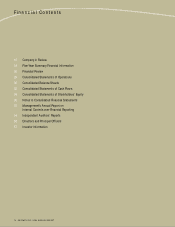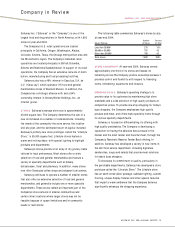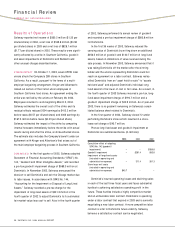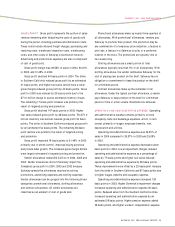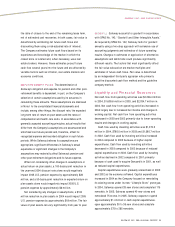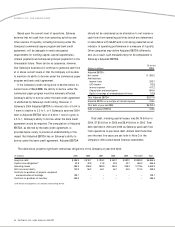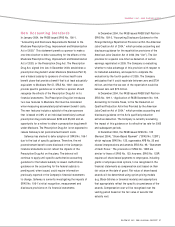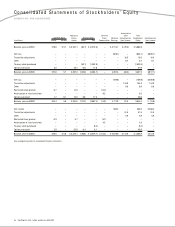Safeway 2004 Annual Report Download - page 26
Download and view the complete annual report
Please find page 26 of the 2004 Safeway annual report below. You can navigate through the pages in the report by either clicking on the pages listed below, or by using the keyword search tool below to find specific information within the annual report.
24 SAFEWAY INC. 2004 ANNUAL REPORT
SAFEWAY INC. AND SUBSIDIARIES
added 15 basis points. The remaining 26-basis-point
increase was primarily due to higher employee benefit
costs, soft sales and settlement income from the
termination of an in-store banking agreement recorded in
2002 operating and administrative expense.
Operating and administrative expense increased 172
basis points in 2002. The Dominick’s impairment charge
added 55 basis points. This increase was partially offset by
a decrease of approximately 9 basis points due to income
received from a bank for the termination of an in-store
banking agreement with Safeway. The remaining 126-basis-
point increase was primarily due to higher employee benefit
costs, higher real estate occupancy costs, higher pension
expense and soft sales.
INTEREST EXPENSE Interest expense was $411.2 million
in 2004, compared to $442.4 million in 2003, and $430.8 in
2002. Interest expense decreased in 2004 primarily due to
lower average borrowings in 2004 compared to 2003.
Interest expense increased in 2003 primarily due to higher
average borrowings in 2003 compared to 2002. Interest
expense declined in 2002 primarily due to lower interest
rates in 2002 compared to 2001.
OTHER INCOM E (LOSS) Other income consists of interest
income, minority interest in a consolidated affiliate and
equity in earnings from Safeway’s unconsolidated affiliates.
Interest income was $9.7 million in 2004, $5.4 million in
2003 and $8.5 million in 2002. Equity in earnings (losses) of
unconsolidated affiliates was income of $12.6 million in
2004, a loss of $ 7.1 million in 2003 and a loss of $0.2
million in 2002. Equity in losses of unconsolidated affiliates
in 2002 includes approximately $15.8 million in charges
related to the resolution of physical inventory count discrep-
ancies at Casa Ley.
Critical Accounting Policies
Critical accounting policies are those accounting policies
that management believes are important to the portrayal of
Safeway’s financial condition and results and require
management’s most difficult, subjective or complex
judgments, often as a result of the need to make estimates
about the effect of matters that are inherently uncertain.
WORKERS’ COMPENSATION The Company is primarily
self-insured for workers’ compensation, automobile and
general liability costs. It is the Company’s policy to record its
self-insurance liability, as determined actuarially, based on
claims filed and an estimate of claims incurred but not yet
reported, discounted at a risk-free interest rate. Any actuarial
projection of losses concerning workers’ compensation and
general liability is subject to a high degree of variability.
Among the causes of this variability are unpredictable
external factors affecting future inflation rates, discount
rates, litigation trends, legal interpretations, benefit level
changes and claim settlement patterns. An example of how
change in discount rates can affect Safeway’s reserve
occurred in 2004 when a 25-basis point increase in the
Company’s discount rate, based on changes in market rates,
reduced its liability by approximately $4.3 million.
The majority of the Company’s workers’ compensation
liability is from claims occurring in California. California
workers’ compensation has received intense scrutiny from
the state’s politicians, insurers, employers and providers, as
well as the public in general. Recent years have seen
escalation in the number of legislative reforms, judicial
rulings and social phenomena affecting this business. Some
of the many sources of uncertainty in the Company’s reserve
estimates include changes in benefit levels, medical fee
schedules, medical utilization guidelines, vocation rehabili-
tation and apportionment.
STORE CLOSURES It is the Company’s policy to recognize
losses relating to the impairment of long-lived assets when
expected net future cash flows are less than the assets’
carrying values. For closed stores that are under long-term
leases, the Company records a liability for the future
minimum lease payments and related ancillary costs from


